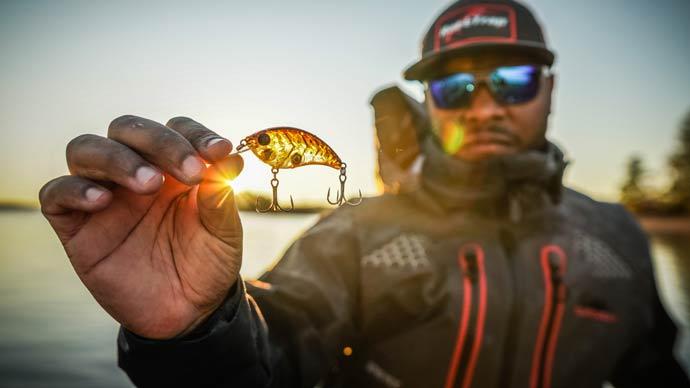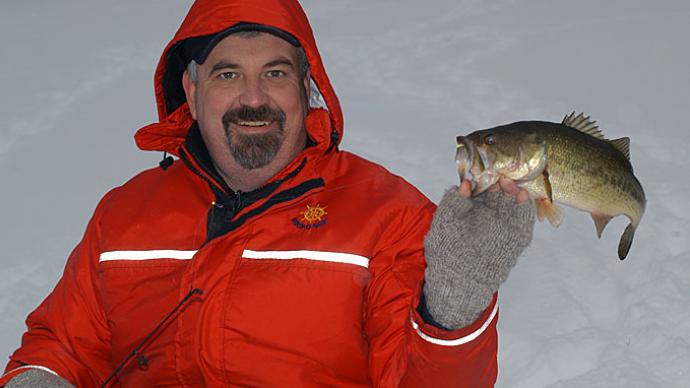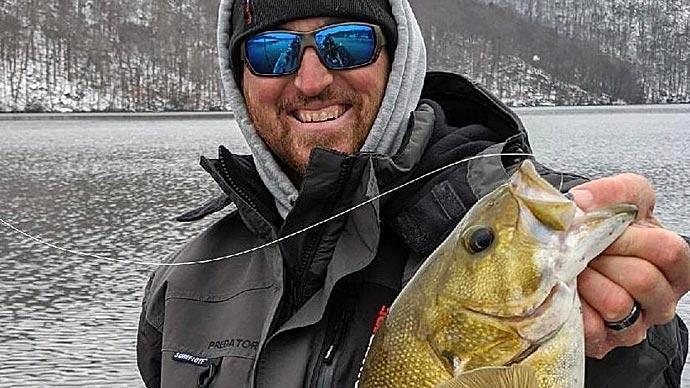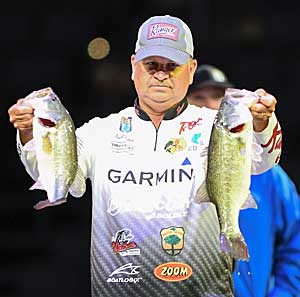
Cold water is relative to where you fish. While there’s always a chance of snow from late fall through early spring in South Carolina, where Bassmaster Elite Series angler Todd Auten makes his home, the weather is never cold enough, for long enough, to keep him off the water. So, he fishes straight through the winter.
Auten considers water cold anytime its temperature is in the low 50s or below. And while that pushes some anglers and bass into deep water, he stays shallow. “You can still catch bass on a crankbait, but you do have to slow down,” he said. He keeps fishing them until the water temperature flirts with 40 degrees. While he’s had success with lipless crankbaits in aquatic vegetation below that point, it usually signifies the need to slow down further, move deeper, and fish jigging spoons, blade baits, and other bottom bouncers.
But not any crankbait will do. Auten said the best ones have the right size, action, and construction. And he’s devised ways to make those even better. But first, he searches out the best places to cast them. “You kind of feel out the lake and see what’s your best way to catch them,” he said. “I always keep an open mind with cold-water cranking.”
Choose your spot
Bass fishing has plenty of rules. One of the oldest is bass won’t bite in cold, dirty water. But rules are meant to be broken, and Auten routinely does that to this one. He said bass are more comfortable in dirty water, so they’re more aggressive and easier to catch. They also are found in shallower water, where rock, brush, and laydowns are his favorite cover to crank.
Bass stay in dirty water because baitfish are there. Auten said if there’s a pocket of dirty water in a creek, baitfish gravitate to it. And while he finds both where clear and dirty water meet, the latter isn’t always the best choice, especially toward the back of creeks in late winter or early spring, when inflow from freezing rain can chill it 10 or 15 degrees below the main lake’s temperature.
Auten cranks cold clear water, too. He stays shallow and starts on rock and rip-rap. Hard cover absorbs solar energy and releases it as heat into the water. While that won’t attract bass from a long distance, it does make those living around it more active. On Lake Wylie, the Catawba River impoundment shared by the Carolinas, he finds plenty of wintertime bass on these spots, even in the middle of the day. “It’s almost like they are sunning themselves in the rocks,” he said.
Beyond rock, Auten cranks for cold-water bass in slightly deeper water. These spots include the outside of creek channel swings and, in the case of Ozark Mountain lakes, such as Table Rock in Missouri, at the end of bluff walls. He matches his crankbait’s diving ability to the spot.
Choose your size, shape, and sound.
Clear water requires a finesse approach. Auten said bass are picky eaters when their metabolism is slowed by cold water. So, he scales down his crankbaits, waiting until a springtime warmup to break out bigger ones. He chooses flat-sided ones, such as the time-tested Rapala Shad Rap or Water Wood Custom Baits’ Triple Trap Deep, which create a tight wobble. Their bills cause them to dive deeper, helping him crank mud or clay points, for example, where he finds some rock or gravel.
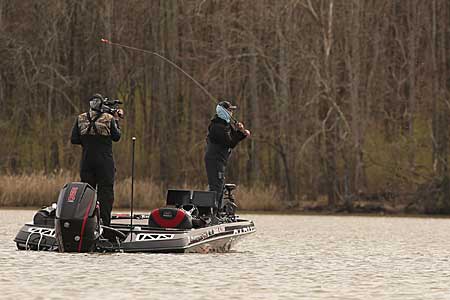
Auten wants his crankbait to create a different action elsewhere. “For me, I want a little more wobble if I’m in muddy water when it’s cold,” he said. So, he reaches for a square-bill crankbait such as Water Wood’s E1. They bounce through rip-rap, rock, brush, and laydowns better. Some of these bills aren’t truly square. Instead, he said they’re a hybrid, featuring straight sides and a slightly rounded leading edge.
Bill material choice comes down to durability. Auten feels lips made from computer board, and those molded into plastic crankbaits last longer than those made from Lexan. And that’s an essential consideration because he still wants to crash his crankbait into structure or cover, as he would in warm water. “You still have to make contact,” he said. “You just have to slow it down.” Making both happen often requires finding a crankbait that dives slightly deeper.
Auten uses two factors — season and water color — to determine his crankbait’s color pattern. Both point to natural schemes when the water is cold, so he leans toward crawfish in stained or muddy water and shad in clear water. “I like to keep it simple,” he said. “Most times, bass don’t care if they’re eating a crawfish or shad.”
A natural pattern has one more benefit. Auten said it helps disguise his crankbait in clear water, where bass can get a good look at it. Hiding it from bass, at least to an extent, adds finesse to his approach. The only exception may be if he’s chasing big smallmouth, then he might switch to bright chartreuse.
Choose your material
The material used to construct a crankbait can be as important as its color or action in cold water. Auten primarily uses plastic ones in dirty water. They usually contain rattles or, in the case of Livingston Lures, emit electronic sounds, which make it easier for bass to find them.
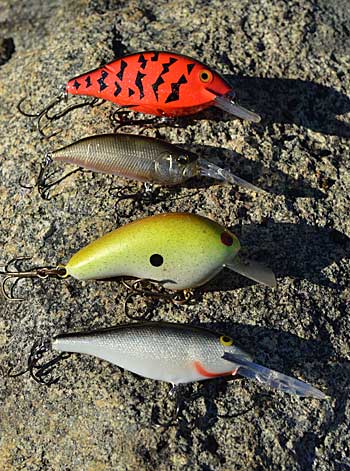
Crankbaits made from cedar, balsa, and other woods are Auten’s choice for fishing cold clear water. Nearly all lack sound, adding to his finesse presentation. But they bring more benefits to the table. He said their quiet nature offers bass, which are curious by nature, something different to investigate. “You’re going to get a different signature in the water,” he said. That can be a difference when most other anglers throw plastic ones. He said you can fish a quiet wooden crankbait behind those anglers and catch bass that they miss.
Many bass anglers won’t fish wood crankbaits despite their advantages. There are several reasons, starting with their light weight, which makes them difficult to cast in the lightest breezes. They can be finicky, too, requiring regular tuning to run straight. Auten said their price, which typically is higher than plastic crankbaits, causes the most hesitation. Anglers are afraid of losing their investment in a laydown, rock pile, or piece of brush. But he doesn’t buy into that. He’s fishing shallow and has a plug knocker at the ready, so it’s a rare snag he can’t free.
Auten believes in wood crankbaits so much that he sells them through Auten Specialty Baits, an online tackle shop he, his wife, and son recently launched. “They always like working with the fishing stuff,” he said. “It’s something that we can do together.” It specializes in hard-to-get tackle, including collectibles, signed lures, and baits from Japan. Water Wood makes some. Its founder, Marcos Malucelli, started sponsoring Auten after the two struck up a friendship while partnered at a Lake Wylie tournament.
Make them better
Every bass angler wants an advantage. And while choosing a wood crankbait is one, Auten said there is more you can do to improve your cold-water crankbaits.
Most wood crankbaits are carved without a rattle. So, when Auten feels he needs one, he installs his own. It’s something that he has done to plenty of Shad Raps. He starts by drilling a hole through the center of the lure that’s just big enough to accept a brass rattle. Once it’s centered in the lure, he seals both ends of the hole with epoxy, sanding it smooth once dry. He said the procedure isn’t complicated to complete, protecting a Shad Rap’s delicate action.
The No. 7 Shad Rap may be the most popular for cranking cold clear water. But on days when conditions are tough and bass finicky, Auten downsizes to the No. 5 version. Measuring 2 inches and weighing 3/16 ounce, it can be difficult to cast. He has a fix for that, too.
The smaller Shad Rap has a slight depression on the nose of its lip. Auten drills a hole that almost goes through the lip and then glues a small split shot inside it. “That gives you a little extra weight so you can throw it farther,” he said.
Auten swaps hooks, too. He prefers larger sizes of short-shanked versions, which keep bass hooked better. And because they incorporate less material, they weigh almost the same as the smaller ones with longer shanks that come on most crankbaits. That protects his crankbait’s action.
Gear up
Crankbaits usually are fished with baitcasting rods and reels. And Auten picks them up when fishing square bills through heavy cover in cold water. He spools his reel with 12-pound test fluorocarbon line. It’s strong enough to extract bass from cover, and its diameter is small enough not to impede his crankbait’s action or maximum diving depth.
Auten selects a spinning rod when it’s time to fish small wood crankbaits. While the thought of using one may make some bass anglers squirm, it’s something that he has become comfortable with for a good reason. It’s easier to fish light-weight line — 8- or 10-pound test fluorocarbon — which means longer casts in clear water. That equates to more bites. And the line’s small diameter, along with the fact that fluorocarbon sinks, helps small crankbaits dive deeper on slower retrieves.
Auten relies on a small wire snap to add security when cranking with lightweight line. He says it lays toward his crankbait’s lip, which rubs the snap instead of the line. Its wobbling creates a sawing action, which can weaken and eventually cut your line without one.
While some anglers are hesitant to trust a snap, worried it will open or break while battling a bass, Auten isn’t. He’s only had it happen once in all his years fishing. And while that cost him a bass, using one has put an almost uncountable number of others in his boat.
BassResource may receive a portion of revenues if you purchase using a link above.


